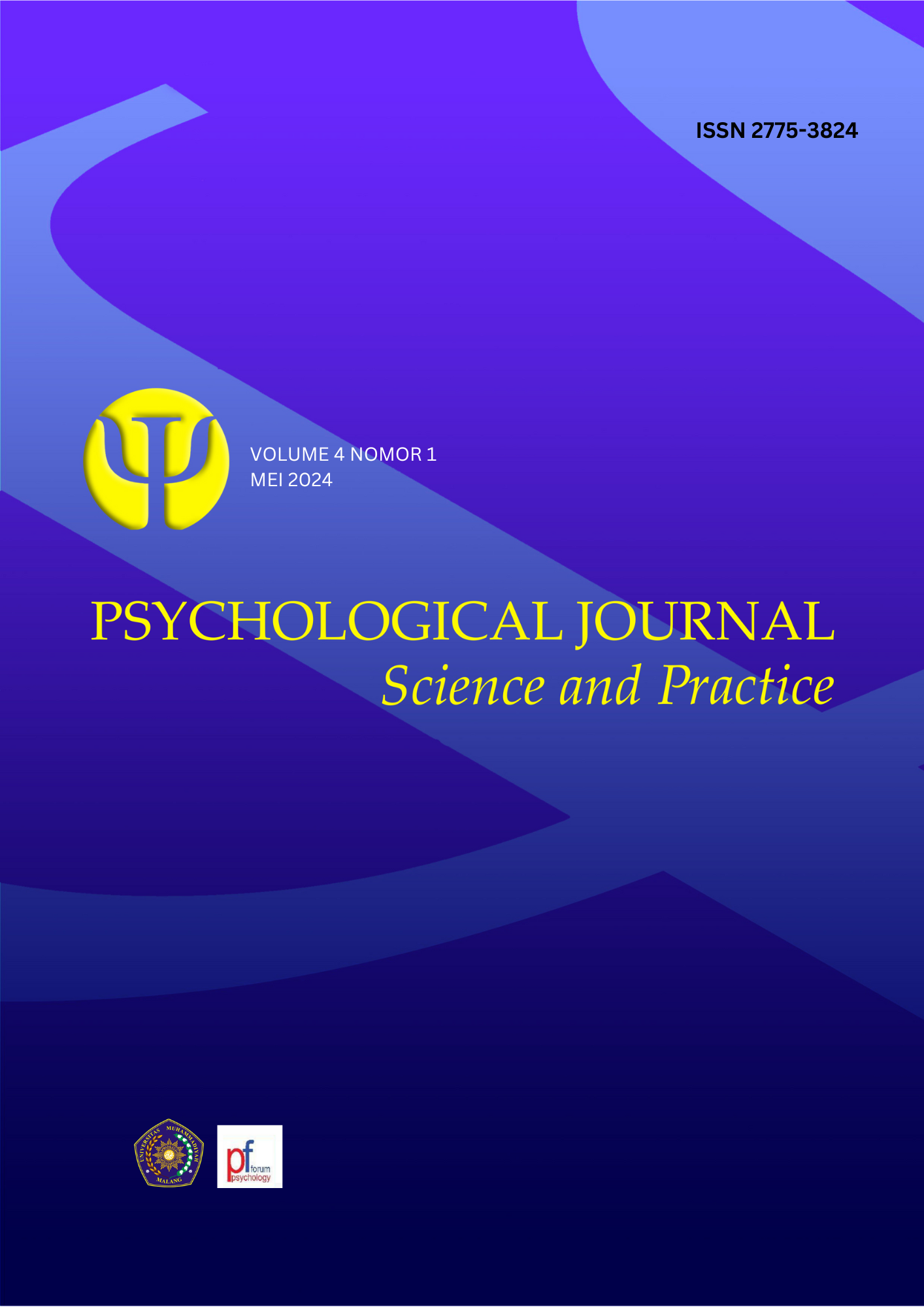Eksplorasi pengalaman dan dinamika coping pada korban Nonsuicide Self-Injury
DOI:
https://doi.org/10.22219/pjsp.v4i1.29032Keywords:
Coping dynamics, nonsuicidal self-injurAbstract
Nonsuicidal self-injury (NSSI) is a mental health problem that has been found in many individuals entering adulthood. At
this age, individuals are often considered unable to solve problems that lead to tendencies to anxiety or depression, not
a few individuals choose to channel their emotions by hurting themselves with sharp objects. This study used qualitative
methods with phenomenological approaches and individuals as non-suicidal self-injury survivors as a unit of analysis.
Participants in this study had age criteria of 18-25 years and one who had done NSSI in the last 6 months. Data collection
techniques use interviews and observation. The results of the data analysis showed that the background of both subjects
doing non-suicidal self-injury was due to the perceived pressure or stress experienced by both subjects. It was found that
to minimize NSSI behavior is to focus on emotional focused-coping including using emotional support, positive reframing,
religion, and self-distraction.
Downloads
References
Aini, A. N., & Puspitasari, D. N. (2022). Jurnal penelitian kualitatif ilmu perilaku dinamika koping pada penyintas Non-Suicidal Self-Injury (NSSI). Jurnal Penelitian Kualitatif Ilmu Perilaku, 3(1).
Aini, A. N. et al. (2022). Jurnal Penelitian Kualitatif Ilmu Perilaku Dinamika Koping pada Penyintas Nonsuicidal Self-Injury (NSSI). Jurnal Penelitian Kualitatif Ilmu Perilaku, 3(1).
Alifiando, B. K. et al. (2022). Gambaran Kecenderungan Perilaku Self-Harm pada Mahasiswa Tingkat Akhir Studi. 8(1), 9–15.
Arinda, O. D. et al. (2020). NSSI (Nonsuicidal Self-Injury) pada Dewasa Muda di Jakarta: Studi fenomenologi interpretatif. Jurnal Psikologi Ulayat, 8(1).
Awalinni, A. et al. (2023). Hubungan antara kesepian dan perilaku non-suicidal self-injury pada mahasiswa psikologi di kota malang. Jurnal Psikologi Teori Dan Terapan, 14(1), 43–59. https://doi.org/10.26740/jptt.v14n1.p43-59
Bismark, M. et al. (2022). Thoughts of suicide or self-harm among Australian healthcare workers during the COVID-19 pandemic. Australian and New Zealand Journal of Psychiatry, 56(12), 1555–1565. https://doi.org/10.1177/00048674221075540
Brown, T. B. et al. (2013). Cutting to Live: A Phenomenology of Self-Harm. Journal of Marital and Family Therapy, 39(2).
Carver, C. S. (1997). You want to measure coping but your protocol’s too long: Consider the brief COPE. International Journal of Behavioral Medicine, 4(1).
Elvira, S. R. et al. (2022). Eksplorasi Pengalaman Nonsuicidal Self-Injury (Nssi) Pada Wanita Dewasa Awal : Sebuah Interpretative Phenomenological Analysis. Jurnal EMPATI, 10(5).
Faradiba, A. T. et al. (2022). Pengalaman Remaja Perempuan Melakukan Deliberate Self-Harm: Sebuah Kajian Fenomenologis. Bulletin of Counseling and Psychotherapy, 4(2), 342–348. https://doi.org/10.51214/bocp.v4i2.280
Favazza, A. R. (2012). Nonsuicidal self-injury: How categorization guides treatment. Current Psychiatry, 11(3).
Gandhi, A. et al. (2018). Association between Non-Suicidal Self-Injury , Parents and Peers Related Loneliness , and Attitude Towards Aloneness in Flemish Adolescents : An Empirical Note. Psychologika Belgica, 58(1), 3–12.
Harahap, A. M. et al. (2024). Curhat sebagai bentuk pendampingan sebaya kepada remaja putri pelaku ngebarcode. Adaptasi : Jurnal Sosial Humaniora Dan Keagamaan, 1(1), 67–87.
Harefa, I. E. et al. (2019). Komunikasi Interpersonal (Self Talk) Sebagai Pencegahan Self- Harm Pada Remaja. Prosiding Seminar Nasional 2019: Pengembangan Karakter Dalam Menghadapi Era Revolusi Industri 4.0, 1(3).
Hart, S. R. et al. (2017). Subtypes of suicide attempters based on longitudinal childhood profiles of co-occurring depressive, anxious and aggressive behavior symptoms. Psychiatry Research, 257.
Hawton, K. et al. (2012). Self-harm and suicide in adolescents. The Lancet, 379(9834).
Herdiansyah, H. (2010). Metodologi Penelitian Kualitatif untuk Ilmu-ilmu Sosial. Salemba Humanika.
Hidayati, F. et al. (2021). Prevalensi dan Fungsi Melukai Diri Sendiri pada Mahasiswa. Tantangan Pembelajaran Komprehensif Untuk Mengembangkan Karakter Peserta Didik : Berdasarkan Pendekatan Psikologi Positif, 1(1).
Ho, K. (2019). Gaya Hidup. YouGov.Com.
Hooley, J. M., Dahlgren, M. K., et al. (2020). Decreased Amygdalar Activation to NSSI-Stimuli in People Who Engage in NSSI: A Neuroimaging Pilot Study. Frontiers in Psychiatry, 11(April).
Hooley, J. M., Fox, K. R., et al. (2020). Nonsuicidal self-injury: Diagnostic challenges and current perspectives. Neuropsychiatric Disease and Treatment.
Karimah, K. (2021). Kesepian dan Kecenderungan Perilaku Menyakiti Diri Sendiri pada Remaja dari Keluarga Tidak Harmonis. Psikoborneo: Jurnal Ilmiah Psikologi, 9(2).
Lazarus, R. S. et al. (1986). Cognitive theories of stress and the issue of circularity. Dynamics of Stress: Physiological, Psychological and Social Perspectives, 6(3).
Long, M. (2018). ‘We’re not monsters … we’re just really sad sometimes:’ hidden self-injury, stigma and help-seeking. Health Sociology Review, 27(1).
Maidah, D. (2013). Self Injury Pada Mahasiswa (Studi Kasus Pada Mahasiswa Pelaku Self Injury). Development and Clinical Psychology, 2(1), 6–13.
Margaretha, A. A. (2019). Gambaran Proses Regulasi Emosi pada Pelaku Self Injury. Jurnal Experentia, 7(2).
Maryam, S. (2017). Strategi Coping: Teori dan Sumber Dayanya. Jurnal Konseling Andi Matappa, 1(2).
Nandela, A. N. (2019). Hubungan Dukungan Sosial Secara Online (Online Social Support) dengan Perilaku Menyakiti Diri (Self-Harm) pada Pengguna Media Sosial Twitter. Universitas Airlangga.
Nugrahawati, L. R. et al. (2023). Relationship between emotional and Spiritual intelligence levels with non-suicidal self-injury (NSSI) behaviour in adolescents during COVID-19 pandemic. Global Medical & Health Communication (GMHC), 11(1), 10–15. https://doi.org/10.29313/gmhc.v11i1.9268
Pardede, A. B. et al. (2022). Self Control Remaja yang Melakukan Self-Harm di Kota Bitung. Psikopedia, 3(2).
Rahayu, A. L. P. et al. (2023). Hubungan Dukungan Sosial Secara Daring Melalui Twitter dengan Perilaku Nonsuicidal Self-Injury pada Remaja. Jurnal Fusion, 3(5).
Raihani, D. et al. (2022). Perilaku Self-harm pada Pasien Depresi dengan Gejala Psikotik. Seminar Nasional Psikologi , 2962–2492.
Rifqi, D. C. (2020). Hubungan Persepsi Dukungan Sosial dan Self-Compassion pada Remaja yang Melakukan Slef Harm. Universitas Negeri Jakarta.
Sadikin, L. M. et al. (2013). Coping stres pada penderita diabetes mellitus pasca amputasi. Jurnal Psikologi Kinis Dan Kesehatan Mental, 2(3).
Siswanto, C. J. et al. (2024). Pengalaman dewasa muda mencari bantuan dalam menghadapi perilaku melukai diri tanpa intensi bunuh diri. Psikostudia; Jurnal Psikologi, 13(1), 26–35. https://doi.org/http://dx.doi.org/10.30872/psikostudia.v13i1 p-ISSN:
Sornberger, M. J. et al. (2013). Nonsuicidal Self-Injury, Coping Strategies, and Sexual Orientation. Journal of Clinical Psychology, 69(6).
Tang, J. et al. (2016). Stressful life events as a predictor for nonsuicidal self-injury in Southern Chinese adolescence: A cross-sectional study. Medicine (United States), 95(9).
Tarigan, T. et al. (2022). Perilaku Self-Harm Atau Melukai Diri Sendiri Yang Dilakukan Oleh Remaja (Self-Harm or Self-Injuring Behavior By Adolescents). Focus : Jurnal Pekerjaan Sosial, 4(2), 213. https://doi.org/10.24198/focus.v4i2.31405
Verenisa, A. et al. (2021). Gambaran Self-Injury Mahasiswa. Jurnal Ilmu Keperawatan Jiwa, 4(1).
Widiyanti, W. et al. (2021). A quasi-experimental study on building a harmonious relationship with mindful self-compassion counseling. Konselor, 10(3).
Wilkinson, P. O. et al. (2018). Sporadic and recurrent non-suicidal self-injury before age 14 and incident onset of psychiatric disorders by 17 years: Prospective cohort study. British Journal of Psychiatry, 212(4), 222–226. https://doi.org/10.1192/bjp.2017.45
Yuliyana et al. (2023). Cognitive behaviour therapy dengan teknik rekonstruksi kognitif untuk mengurangi perilaku self-harm peserta didik di SMAN 2 tarakan. Jurnal Pemikiran Dan Pengembangan Pembelajaran, 5(3), 229–234.
Zhang, B. et al. (2023). Relationship between alexithymia , loneliness , resilience and non-suicidal self-injury in adolescents with depression : a multi-center study. BMC Psychiatri, 23(445), 1–11.
Downloads
Published
How to Cite
Issue
Section
License
Copyright (c) 2024 Indah Sari Dewi Zulkifli

This work is licensed under a Creative Commons Attribution-ShareAlike 4.0 International License.
Authors who publish with Psychological Journal: Science and Practice (PJSP) agree to the following terms:
- For all articles published in Psychological Journal: Science and Practice (PJSP), copyright is retained by the authors. Authors give permission to the publisher to announce the work with conditions. When the manuscript is accepted for publication, the authors agree to automatic transfer of the publishing right to the publisher.
- Authors retain copyright and grant the journal right of first publication with the work simultaneously licensed under a Creative Commons Attribution-ShareAlike 4.0 International License that allows others to share the work with an acknowledgment of the work's authorship and initial publication in this journal.
- Authors are able to enter into separate, additional contractual arrangements for the non-exclusive distribution of the journal's published version of the work (e.g., post it to an institutional repository or publish it in a book), with an acknowledgment of its initial publication in this journal.
- Authors are permitted and encouraged to post their work online (e.g., in institutional repositories or on their website) prior to and during the submission process, as it can lead to productive exchanges, as well as earlier and greater citation of published wor (See The Effect of Open Access).
This work is licensed under a Creative Commons Attribution-ShareAlike 4.0 International License.








